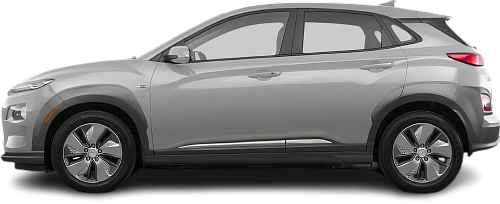USA EV Comparison: Hyundai Kona Electric Standard Range vs Kia Soul EV Standard Range
Struggling to Decide? Let AI Help!
Your AI Summary Is Ready!
General Info
While the Kia Soul EV Standard Range (2020-…) is currently produced, it is not offered for sale in the United States. The Hyundai Kona Electric Standard Range (2018-2019) has been discontinued, it was never offered for sale in the United States.
The two vehicles share the same body style: SUV.
| Property | Hyundai Kona Electric Standard Range | Kia Soul EV Standard Range |
|---|---|---|
| Years of Production | 2018-2019 | 2020-… |
| Current Status | Discontinued | Produced |
| Country of Manufacture | South Korea | South Korea |
| Body Style | SUV | SUV |
| Market Availability | EU | EU |
| GCC Score | 5.2 | 5.1 |
Range and Efficiency
Although both cars have the same battery capacity, Hyundai Kona Electric Standard Range (2018-2019) achieves a longer real-world range due to its superior energy efficiency.
| Property | Hyundai Kona Electric Standard Range | Kia Soul EV Standard Range |
|---|---|---|
| Range (WLTP) | 180 mi | 171 mi |
| Range (GCC) | 153 mi | 146 mi |
| Battery Capacity (Nominal) | 42 kWh | 42 kWh |
| Battery Capacity (Usable) | 39.2 kWh | 39.2 kWh |
| Efficiency per 100 mi | 25.6 kWh/100 mi | 26.8 kWh/100 mi |
| Efficiency per kWh | 3.9 mi/kWh | 3.72 mi/kWh |
| Range and Efficiency Score | 5.8 | 5.4 |
Charging
Both vehicles utilize a standard 400-volt architecture.
Both vehicles support DC fast charging with a maximum power of 44 kW.
Both vehicles are equipped with the same on-board charger, supporting a maximum AC charging power of 7.2 kW.
| Property | Hyundai Kona Electric Standard Range | Kia Soul EV Standard Range |
|---|---|---|
| Max Charging Power (AC) | 7.2 kW | 7.2 kW |
| Max Charging Power (DC) | 44 kW | 44 kW |
| Architecture | 400 V | 400 V |
| Charge Port | CCS Type 2 | CCS Type 2 |
| Charging Score | 4 | 4 |
Performance
Both vehicles are front-wheel drive.
Both cars offer the same motor power, but the Hyundai Kona Electric Standard Range (2018-2019) achieves a faster 0-60 mph time.
| Property | Hyundai Kona Electric Standard Range | Kia Soul EV Standard Range |
|---|---|---|
| Drive Type | FWD | FWD |
| Motor Type | PMSM | PMSM |
| Motor Power (kW) | 100 kW | 100 kW |
| Motor Power (hp) | 134 hp | 134 hp |
| Motor Torque | 291 lb-ft | 291 lb-ft |
| 0-60 mph | 9.3 s | 9.5 s |
| Top Speed | 96 mph | 97 mph |
| Performance Score | 3.1 | 3.1 |
Dimensions
The Kia Soul EV Standard Range (2020-…) is taller, but has a similar length and width to the Hyundai Kona Electric Standard Range (2018-2019).
Both models have similar wheelbase lengths.
| Property | Hyundai Kona Electric Standard Range | Kia Soul EV Standard Range |
|---|---|---|
| Length | 164.6 in | 165.2 in |
| Width (with Mirrors) | 81.5 in | - Width (with Mirrors) |
| Width (w/o Mirrors) | 70.9 in | 70.9 in |
| Height | 61.8 in | 63.2 in |
| Wheelbase | 102.4 in | 102.4 in |
Cargo and Towing
The Hyundai Kona Electric Standard Range (2018-2019) features a larger trunk, but the Kia Soul EV Standard Range (2020-…) offers greater maximum cargo capacity when the rear seats are folded.
Neither car is equipped with a frunk (front trunk).
Neither vehicle is officially rated for towing in the US.
| Property | Hyundai Kona Electric Standard Range | Kia Soul EV Standard Range |
|---|---|---|
| Number of Seats | 5 | 5 |
| Curb Weight | 3549 lb | 3549 lb |
| Cargo Volume (Trunk) | 19.2 ft3 | 11.1 ft3 |
| Cargo Volume (Max) | 45.8 ft3 | 47.3 ft3 |
| Cargo Volume (Frunk) | - Cargo Volume (Frunk) | - Cargo Volume (Frunk) |
| Towing Capacity | - Towing Capacity | - Towing Capacity |
| Cargo and Towing Score | 5.3 | 5.5 |




